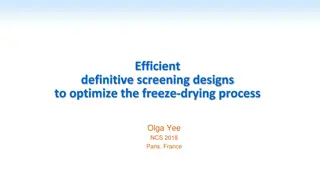
Lyophilization: Process, Applications, and Benefits
Explore the definition, stages, and applications of lyophilization, a low-temperature dehydration process involving freezing and sublimation. Discover the advantages, disadvantages, and the vital role of lyophilization in space missions and military rations.
Download Presentation

Please find below an Image/Link to download the presentation.
The content on the website is provided AS IS for your information and personal use only. It may not be sold, licensed, or shared on other websites without obtaining consent from the author. If you encounter any issues during the download, it is possible that the publisher has removed the file from their server.
You are allowed to download the files provided on this website for personal or commercial use, subject to the condition that they are used lawfully. All files are the property of their respective owners.
The content on the website is provided AS IS for your information and personal use only. It may not be sold, licensed, or shared on other websites without obtaining consent from the author.
E N D
Presentation Transcript
StudyMafia.Org Lyophilization Submitted To: Submitted By: Studymafia.org Studymafia.org
Table Contents Definition Introduction Stages of Lyophilization Applications of Lyophilization Advantages of Lyophilization Disadvantages of Lyophilization Conclusion 2
Definition Freeze drying, also known as lyophilization or cryodesiccation, is a low temperature dehydration process that involves freezing the product and lowering pressure, removing the ice by sublimation. 3
Introduction Freeze-dried foods became a major component of astronaut and military rations. What began for astronaut crews as tubed meals and freeze-dried snacks that were difficult to rehydrate, were transformed into hot meals in space by improving the process of rehydrating freeze-dried meals with water. 4
Stages of Lyophilization Pretreatment Pretreatment includes any method of treating the product prior to freezing. This may include concentrating the product, formulation revision (i.e., addition of components to increase stability, preserve appearance, and/or improve processing), decreasing a high-vapor-pressure solvent, or increasing the surface area. 6
Stages of Lyophilization Freezing and annealing During the freezing stage, the material is cooled below its triple point, the temperature at which the solid, liquid, and gas phases of the material can coexist. This ensures that sublimation rather than melting will occur in the following steps. To facilitate faster and more efficient freeze drying, larger ice crystals are preferable. 7
Stages of Lyophilization Primary drying During the primary drying phase, the pressure is lowered (to the range of a few millibars), and enough heat is supplied to the material for the ice to sublimate. The amount of heat necessary can be calculated using the sublimating molecules' latent heat of sublimation. In this initial drying phase, about 95% of the water in the material is sublimated. 8
Stages of Lyophilization Secondary drying The secondary drying phase aims to remove unfrozen water molecules, since the ice was removed in the primary drying phase. In this phase, the temperature is raised higher than in the primary drying phase, and can even be above 0 C (32 F), to break any physico- chemical interactions that have formed between the water molecules and the frozen material. 9
Applications of Lyophilization Freeze-drying causes less damage to the substance than other dehydration methods using higher temperatures. Nutrient factors that are sensitive to heat are lost less in the process as compared to the processes incorporating heat treatment for drying purposes. Freeze-drying does not usually cause shrinkage or toughening of the material being dried. 10
Applications of Lyophilization In addition, flavours, smells, and nutritional content generally remain unchanged, making the process popular for preserving food. However, water is not the only chemical capable of sublimation, and the loss of other volatile compounds such as acetic acid (vinegar) and alcohols can yield undesirable results. 11
Applications of Lyophilization Freeze-dried products can be rehydrated (reconstituted) much more quickly and easily because the process leaves microscopic pores. The pores are created by the ice crystals that sublimate, leaving gaps or pores in their place. This is especially important when it comes to pharmaceutical uses. 12
Advantages of Lyophilization Shelf-life extension Shelf-life extension results from low processing temperatures in conjunction with rapid transition of water through sublimation. Re-hydration If a dried product cannot be easily or fully re- hydrated, it is considered to be of lower quality. 13
Disadvantages of Lyophilization Microbial growth Since the main method of microbial decontamination for freeze drying is the low temperature dehydration process, spoilage organisms and pathogens resistant to these conditions can remain in the product. 14
Disadvantages of Lyophilization Cost Freeze-drying costs about five times as much as conventional drying, so it is most suitable for products which increase in value with processing. Costs are also variable depending on the product, the packaging material, processing capacity, etc. 15
Disadvantages of Lyophilization Silicone oil leakage Silicone oil is the common fluid that is used to heat or cool shelves in the freeze-dryer. The continuous heat/cool cycle can lead to a leakage of silicone oil at weak areas that connect the shelf and hose. This can contaminate the product leading to major losses of pharmaceuticals and food products. 16
Conclusion Lyophilization or freeze drying is a process in which water is removed from a product after it is frozen and placed under a vacuum, allowing the ice to change directly from solid to vapor without passing through a liquid phase. 17
References Google.com Wikipedia.org Studymafia.org Slidespanda.com
Thanks To StudyMafia.org

